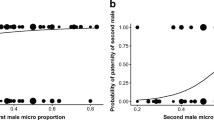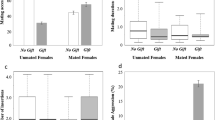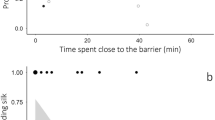Abstract
In the scorpionfly Panorpa cognata, males provide females with saliva secretions as nuptial food gifts. Consequently, females derive material benefits and possibly also genetic benefits from multiple matings. Females therefore generally should have a high motivation to remate. Males, on the other hand, do not share this interest, which will generate a sexual conflict over remating interval, possibly leading to male adaptations that prevent females from remating with other males. In this study, I found that mated females were less prone to copulate than virgin females, despite female benefits of multiple matings. Further, I found that the remating interval was significantly longer if the first copulation was long compared to shorter matings. This effect does not entirely depend on copulation duration per se, but on the amount of saliva, that a female is consuming during copulation. These results suggest a mating-induced refractory period and can be interpreted as male manipulation of female remating behaviour mediated through substances in the nuptial gift. Alternatively, receiving large nuptial gifts may decrease the prospective direct fitness benefits from further copulations, and thus change optimal female remating rate. Furthermore, gift size has been shown to correlate with male nutritional condition, which may be an indicator of male genetic quality. Females may therefore benefit indirectly by not remating following copulations involving large saliva gifts. In this scenario, female remating interval would be an effect of cryptic female choice.
Similar content being viewed by others
References
Alatalo RV, Kotiaho J, Mappes J, Parri S (1998) Mate choice for offspring performance: major benefits or minor costs? Proc R Soc Lond B 265:2297–2301
Alcock J (1994) Postinsemination associations between males and females in insects: the mate-guarding hypothesis. Annu Rev Entomol 39:1–21
Andersson J, Borg-Karlson AK, Wiklund C (2000) Sexual cooperation and conflict in butterflies: a male-transferred anti-aphrodisiac reduces harassment of recently mated females. Proc R Soc Lond B 267:1271–1275
Andersson J, Borg-Karlson AK, Wiklund C (2004) Sexual conflict and anti-aphrodisiac titre in a polyandrous butterfly: male ejaculate tailoring and absence of female control. Proc R Soc Lond B 271:1765–1770
Arnqvist G, Nilsson T (2000) The evolution of polyandry: multiple mating and female fitness in insects. Anim Behav 60:145–164
Arnqvist G, Rowe L (2005) Sexual conflict. Princeton University Press, Princeton
Baer B, Morgan ED, Schmid-Hempel P (2001) A nonspecific fatty acid within the bumblebee mating plug prevents females from remating. Proc Natl Acad Sci USA 98:3926–3928
Bernays EA, Simpson SJ (1982) The control of food intake. Adv Insect Physiol 16:59–118
Birkhead TR, Martinez JG, Burke T, Froman DP (1999) Sperm mobility determines the outcome of sperm competition in the domestic fowl. Proc R Soc Lond B 266:1759–1764
Bockwinkel G, Sauer KP (1994) Resource dependence of male mating tactics in the scorpionfly, Panorpa vulgaris (Mecoptera, Panorpidae). Anim Behav 47:203–209
Brown WD (1997) Female remating and the intensity of female choice in black-horned tree crickets, Oecanthus nigricornis. Behav Ecol 8:66–74
Byers GW, Thornhill R (1983) Biology of the Mecoptera. Annu Rev Entomol 28:203–228
Chapman T, Miyatake T, Smith HK, Partridge L (1998) Interactions of mating, egg production and death rates in females of the Mediterranean fruit fly, Ceratitis capitata. Proc R Soc Lond B 265:1879–1894
Chen PS (1984) The functional-morphology and biochemistry of insect male accessory-glands and their secretions. Annu Rev Entomol 29:233–255
Cook PA, Gage MJG (1995) Effects of risks of sperm competition on the numbers of eupyrene and apyrene sperm ejaculated by the moth Plodia interpunctella (Lepidoptera, Pyralidae). Behav Ecol Sociobiol 36:261–268
Cook PA, Wedell N (1999) Non-fertile sperm delay female remating. Nature 397:486
Dickinson JL (1986) Prolonged mating in the milkweed beetle Labidomera clivicollis clivicollis (Cleoptera: Chrysomelidae): a test of the “sperm loading” hypothesis. Behav Ecol Sociobiol 18:331–338
Dziuk PJ (1996) Factors that influence the proportion of offspring sired by a male following heterospermic insemination. Anim Reprod Sci 43:65–88
Eady PE (1995) Why do male Callosobruchus maculatus beetles inseminate so many sperm? Behav Ecol Sociobiol 36:25–32
Eberhard WG (1996) Female control: sexual selection by cryptic female choice. Princeton University Press, Princeton, NJ
Eberhard WG, Cordero C (1995) Sexual selection by cryptic female choice on male seminal products—a new bridge between sexual selection and reproductive physiology. Trends Ecol Evol 10:493–496
Engqvist L (2006) Females benefit from mating with different males in the scorpionfly Panorpa cognata. Behav Ecol 17:435–440
Engqvist L, Sauer KP (2001) Strategic male mating effort and cryptic male choice in a scorpionfly. Proc R Soc Lond B 268:729–735
Engqvist L, Sauer KP (2002) Amorous scorpionflies: causes and consequences of the long pairing prelude of Panorpa cognata. Anim Behav 63:667–675
Engqvist L, Sauer KP (2003a) Determinants of sperm transfer in the scorpionfly Panorpa cognata: male variation, female condition and copulation duration. J Evol Biol 16:1196–1204
Engqvist L, Sauer KP (2003b) Influence of nutrition on courtship and mating behaviour in the scorpionfly Panorpa cognata. Ethology 109:911–928
Fleischman RR, Sakaluk SK (2004) Sexual conflict over remating in house crickets: no evidence of an anti-aphrodisiac in males’ ejaculates. Behaviour 141:633–646
Fox GA (2001) Failure-time analysis: emergence, flowering, survivorship, and other waiting times. In: Scheiner SM, Gurevitch J (eds) Design and analysis of ecological experiments. Oxford University Press, Oxford, pp 253–289
Härdling R, Kaitala A (2005) The evolution of repeated mating under sexual conflict. J Evol Biol 18:106–115
He Y, Tsubaki Y (1991) Effects of spermatophore size on female re-mating in the armyworm, Pseudoletia separata with reference to larval crowding. J Ethol 9:47–50
Holland B, Price WR (1998) Chase-away sexual selection: antagonistic seduction versus resistance. Evolution 52:1–7
Ihaka R, Gentleman R (1996) R: a language for data analysis and graphics. J Comput Graph Statist 5:299–314
Jennions MD, Petrie M (2000) Why do females mate multiply? A review of the genetic benefits. Biol Rev 75:21–64
Johnson JC, Ivy TM, Sakaluk SK (1999) Female remating propensity contingent on sexual cannibalism in sagebrush crickets, Cyphoderris strepitans: a mechanism of cryptic female choice. Behav Ecol 10:227–233
Kirkpatrick M (1996) Good genes and direct selection in evolution of mating preferences. Evolution 50:2125–2140
Kirkpatrick M, Barton NH (1997) The strength of indirect selection on female mating preferences. Proc Natl Acad Sci USA 94:1282–1286
Leopold RA (1976) The role of male accessory glands in insect reproduction. Annu Rev Entomol 21:199–221
Lewis SM, Austad SN (1990) Sources of intraspecific variation in sperm precedence in red flour beetles. Am Nat 135:351–359
Mercier L (1915) Caractère sexuel secondaire chez les Panorpes: le rôle des glandes salivaires des males. Arch Zool Exp 55:1–5
Miyatake T, Chapman T, Partridge L (1999) Mating-induced inhibition of remating in female Mediterranean fruit flies Ceratitis capitata. J Insect Physiol 45:1021–1028
Møller AP, Jennions MD (2001) How important are direct fitness benefits of sexual selection? Naturwissenschaften 88:401–415
Oberhauser KS (1989) Effects of spermatophores on male and female monarch butterfly reproductive success. Behav Ecol Sociobiol 25:237–246
Parker GA (1970) Sperm competition and its evolutionary consequences in the insects. Biol Rev 45:525–567
Parker GA (1979) Sexual selection and sexual conflict. In: Blum MS, Blum NA (eds) Sperm competition and the evolution of animal mating systems. Academic Press, New York, pp 1–60
Parker GA, Simmons LW (1989) Nuptial feeding in insects: theoretical models of male and female interests. Ethology 82:3–26
Parker GA, Partridge L (1998) Sexual conflict and speciation. Philos Trans R Soc Lond B 353:261–274
Parker GA, Simmons LW, Kirk H (1990) Analysing sperm competition data: simple models for predicting mechanisms. Behav Ecol Sociobiol 27:55–65
Polak M, Wolf LL, Starmer WT, Barker JSF (2001) Function of the mating plug in Drosophila hibisci Bock. Behav Ecol Sociobiol 49:196–205
Sakaluk SK (1991) Post-copulatory mate guarding in decorated crickets. Anim Behav 41:207–216
Sakaluk SK, Eggert A-K (1996) Female control of sperm transfer and intraspecific variation in sperm. Evolution 50:694–703
Sakaluk SK, Avery RL, Weddle CB (2006) Cryptic sexual conflict in gift-giving insects: chasing the chase-away. Am Nat 167:94–104
Sauer KP (1970) Zur Monotopbindung einheimischer Arten der Gattung Panorpa (Mecoptera) nach Untersuchungen im Freiland und im Laboratorium. Zool Jahrb Syst 97:201–284
Sauer KP (1977) The adaptive significance of genetic variability of photoperiodic response in Panorpa vulgaris. Zool Jahrb Syst 104:489–538
Sauer KP, Lubjuhn T, Sindern J, Kullmann H, Kurtz J, Epplen C, Epplen JT (1998) Mating system and sexual selection in the scorpionfly Panorpa vulgaris (Mecoptera: Panorpidae). Naturwissenschaften 85:219–228
Sillén-Tullberg B (1981) Prolonged copulation—a male post-copulatory strategy in a promiscuous species, Lygaeus equestris (Heteroptera, Lygaeidae). Behav Ecol Sociobiol 9:283–289
Simmons LW (2001) Sperm competition and its evolutionary consequences in the insects. Princeton University Press, Princeton, NJ
Simmons LW (2005) The evolution of polyandry: sperm competition, sperm selection, and offspring viability. Ann Rev Ecol Evol Syst 36:125–146
Simmons LW, Parker GA (1989) Nuptial feeding in insects: mating effort versus paternal investment. Ethology 81:332–343
Simmons LW, Gwynne DT (1991) The refractory period of female katydids (Orthoptera: Tettigonidae): sexual conflict over the remating interval? Behav Ecol 2:276–282
Simmons LW, Alcock J, Reeder A (2003) The role of cuticular hydrocarbons in male attraction and repulsion by female Dawson’s burrowing bee, Amegilla dawsoni. Anim Behav 66:677–685
Siva-Jothy MT, Stutt AD (2003) A matter of taste: direct detection of female mating status in the bedbug. Proc R Soc Lond B 270:649–652
Stockley P (1997) Sexual conflict resulting from adaptations to sperm competition. Trends Ecol Evol 12:154–159
Sugawara T (1979) Stretch reception in the bursa copulatrix of the butterfly, Pieris rapae crucivora, and its role in behavior. J Comp Physiol 130:191–199
Takakura K (2001) Courtship-role-reversal in the bean weevil, Bruchidius dorsalis (Coleoptera: Bruchidae): interplay between male-male competition and cryptic female choice. Appl Entomol Zoolog 36:311–316
Therneau TM, Grambsch PM (2004) Modeling survival data: extending the Cox model, 3rd edn. Springer, New York
Thornhill R (1976) Sexual selection and nuptial feeding behaviour in Bittacus apicalis (Insecta: Mecoptera). Am Nat 110:529–548
Thornhill R (1979) Male pair-formation pheromones in Panorpa scorpionflies (Mecoptera: Panorpidae). Environ Entomol 8:886–888
Thornhill R (1980) Competition and coexistence among Panorpa scorpionflies (Mecoptera: Panorpidae). Ecol Monogr 50:179–197
Thornhill R (1981) Panorpa (Mecoptera: Panorpidae) scorpionflies: systems for understanding resource-defense polygyny and alternative male reproductive efforts. Ann Rev Ecol Syst 12:355–386
Thornhill R (1983) Cryptic female choice and its implications in the scorpionfly Harpobittacus nigriceps. Am Nat 122:765–788
Thornhill R, Sauer KP (1992) Genetic sire effects on the fighting ability of sons and daughters and mating success of sons in a scorpionfly. Anim Behav 43:255–264
Tregenza T, Wedell N (2000) Genetic compatibility, mate choice and patterns of parentage: invited review. Mol Ecol 9:1013–1027
Tsubaki Y, Sokei Y (1988) Prolonged mating in the melon fly, Dacus cucurbitae (Diptera: Tephritidae): competition for fertilization by sperm-loading. Res Popul Ecol 30:343–352
Vahed K (1998) The function of nuptial feeding in insects: a review of empirical studies. Biol Rev 73:43–78
Weddle CB, Sakaluk SK (2003) Ingestion of male haemolymph and mating propensity of female sagebrush crickets: no evidence of a male-derived antiaphrodisiac. Anim Behav 65:83–88
Wedell N (1993) Spermatophore size in bushcrickets: comparative evidence for nuptial gifts as a sperm protection device. Evolution 47:1203–1212
Wedell N (2005) Female receptivity in butterflies and moths. J exp Biol 208:3433–3440
Wedell N, Arak A (1989) The wartbiter spermatophore and its effect on female reproductive output (Orthoptera: Tettigonidae, Decticus verrucivorus). Behav Ecol Sociobiol 24:117–125
Whitlock MC (2005) Combining probability from independent tests: the weighted Z-method is superior to Fisher’s approach. J Evol Biol 18:1368–1373
Wiklund C, Kaitala A (1995) Sexual selection for large male size in a polyandrous butterfly: the effect of body size on male versus female reproductive success in Pieris napi. Behav Ecol 6:6–13
Wiklund C, Karlsson B, Leimar O (2001) Sexual conflict and cooperation in butterfly reproduction: a comparative study of polyandry and female fitness. Proc R Soc Lond B 268:1661–1667
Zeh JA, Zeh DW (2003) Toward a new sexual selection paradigm: polyandry, conflict and incompatibility. Ethology 109:929–950
Acknowledgements
I thank Joachim Frommen, Roger Härdling and two anonymous reviewers for helpful comments on the manuscript and Kim Schmidt, Nicole Schmidt and Monika Kräling for help with laboratory work. This study was supported by the Deutsche Forschungsgemeinschaft [EN 469/1-1].
Author information
Authors and Affiliations
Corresponding author
Rights and permissions
About this article
Cite this article
Engqvist, L. Nuptial gift consumption influences female remating in a scorpionfly: male or female control of mating rate?. Evol Ecol 21, 49–61 (2007). https://doi.org/10.1007/s10682-006-9123-y
Published:
Issue Date:
DOI: https://doi.org/10.1007/s10682-006-9123-y




